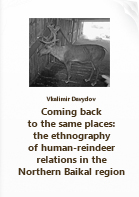Coming back to the same places: the ethnography of human-reindeer relations in the Northern Baikal region
This article is based on the results of recent fieldwork among the Evenk reindeer herders in the northern Baikal region. It argues that reindeer domestication should be approached as a never-ending process that happens in the context of animal and human movement and can be described as domestication-in-practice and domestication-on-the-move. An important signal of the fact that animals became closer to people is their constant return to a camp. This article presents the ethnography of how people try to facilitate these returns by feeding reindeer with salt, producing smoke and binding calves to stakes and poles. On the one hand, animals periodically come back to a camp. On the other hand, reindeer herders know the places to which the animals return outside the camp and this helps them to find reindeer in certain places. Reindeer herding in the northern Baikal region is based on constant relocation of the herd from place to place, implying daily short-term movement in order to bring animals to the camp and meaning a continuous monitoring of reindeer and predator movements.

